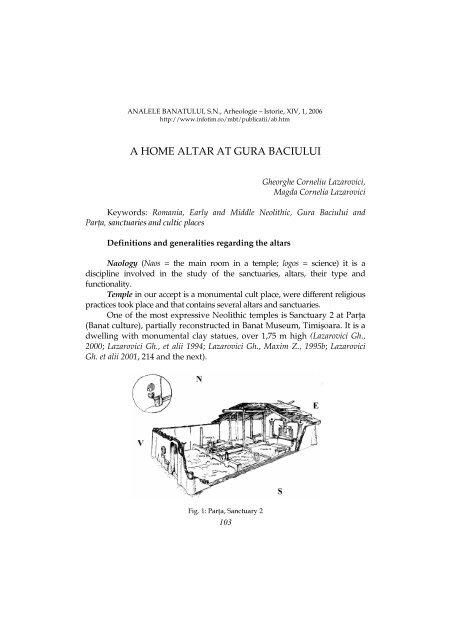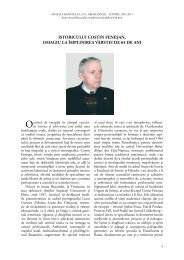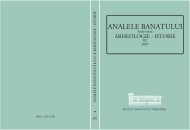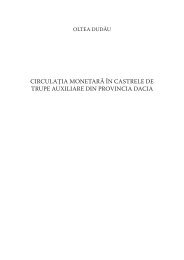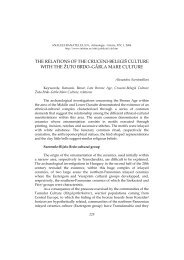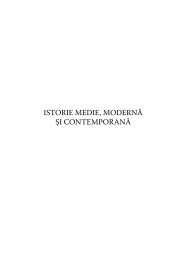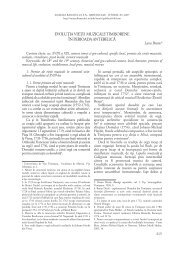A HOME ALTAR AT GURA BACIULUI - Muzeul Banatului
A HOME ALTAR AT GURA BACIULUI - Muzeul Banatului
A HOME ALTAR AT GURA BACIULUI - Muzeul Banatului
Create successful ePaper yourself
Turn your PDF publications into a flip-book with our unique Google optimized e-Paper software.
ANALELE BAN<strong>AT</strong>ULUI, S.N., Arheologie – Istorie, XIV, 1, 2006<br />
http://www.infotim.ro/mbt/publicatii/ab.htm<br />
A <strong>HOME</strong> <strong>ALTAR</strong> <strong>AT</strong> <strong>GURA</strong> <strong>BACIULUI</strong><br />
103<br />
Gheorghe Corneliu Lazarovici,<br />
Magda Cornelia Lazarovici<br />
Keywords: Romania, Early and Middle Neolithic, Gura Baciului and<br />
��� ���������������������������������<br />
Definitions and generalities regarding the altars<br />
Naology (Naos = the main room in a temple; logos = science) it is a<br />
discipline involved in the study of the sanctuaries, altars, their type and<br />
functionality.<br />
Temple in our accept is a monumental cult place, were different religious<br />
practices took place and that contains several altars and sanctuaries.<br />
������������������������������������������������������������������ ��<br />
�����������������������������������������������������������������������������<br />
dwelling with monumental clay statues, over 1,75 m high (Lazarovici Gh.,<br />
2000; Lazarovici Gh., et alii 1994; Lazarovici Gh., Maxim Z., 1995b; Lazarovici<br />
Gh. et alii 2001, 214 and the next).<br />
Fig. 1:���� ��������������
ANALELE BAN<strong>AT</strong>ULUI, XIV, 1, 2006<br />
The temple or Sanctuary 2������� ������������������������������������<br />
divinities, fig. 1: Great Mother (with a human or cow head) with the Bull<br />
partner; Sun and Moon. In the same place it was also noticed a cult related<br />
with the pillar, axis mundi; there are lonely or double pillars at the<br />
�������������������������������������������������� ���������������������������<br />
related with the sacral rituals:<br />
� The monumental altar with the double statue has a pedestal for<br />
offerings deposition;<br />
� Altar A was used for ritual burning;<br />
� Altar B, used for the deposition of different products in pots (pot<br />
with a human face that contains bones and other 6-7 pots (some<br />
destroyed or missing because of a later digging for a well).<br />
� Altar C, used for the ritual depositions of cereals dedicated to the<br />
couple Sun – Moon;<br />
� Altar D, used for ritual depositions and blood sacrifices for the<br />
couple Great Mother – Bull;<br />
� Cultic grinding is proved by a grind (with a clay bed for the<br />
flour) find on the western wall of the sanctuary and a cup on top<br />
of it, fig. 1. Above these, another round span was in the wall,<br />
decorated with a clay Moon, suggesting the Sun-Moon couple<br />
(Lazarovici Gh. et alii 2003; Lazarovici Gh. 2003).<br />
� Altar E, used for ritual offerings dedicated to the couple Great<br />
Mother – Bull and other;<br />
� The rectangular span in front of the main double statue<br />
designated to the light adoration was oriented to the east, to the<br />
sun rising. This span was decorated with two columns/pillars<br />
ended with bullheads, having different symbols between the<br />
horns for the Sun and respectively the Moon.<br />
�������������������������������������� �.<br />
In other dwellings monumental objects have been found: some of<br />
them have been used as totems, other have maybe a sacral role for offerings<br />
or burning, associated with cassettes and marking small altars.<br />
104
Fig. 2:������������������� �����������-6<br />
��������������������� ��<br />
� Altar A was used for burning and offering deposition (portable<br />
fireplace, socle for an idol-bust and ashes, cassettes);<br />
� Altar B was used for blood offerings (birds, small animals);<br />
� Altar C was used for burning cereals or other straw offerings<br />
(fireplace, pit in the eastern part of the sanctuary).<br />
Fig. 3: ��� ��������������<br />
105
ANALELE BAN<strong>AT</strong>ULUI, XIV, 1, 2006<br />
Monumental pieces have been found in each big block of houses on<br />
the walls. They indicate the place of a home altar/shrine or the place of a<br />
family totem:<br />
� House of the Moon;<br />
� House of the Deer;<br />
� House of the pillar and of the bull head;<br />
We believe that is quite difficult to separate the communitarian and<br />
home altars or sanctuaries, but they represent models of imagination in the<br />
Danube area or for the mythology of Early and Developed Neolithic.<br />
The appearance of the monumental altars, clay pillars, monumental<br />
blocks of clay or stone is very old. In the Near East, sanctuaries are noted in<br />
8/7 millennia at Göbelki Tepe, Nevala Çori etc. (Hauptmann H., 1993;<br />
Hauptmann H., Schmidt K., 2000; Schmidt 1997/1998; 1999; 2000); later on, in<br />
7/6 millennia only at Çatal Hüyük there are over 30 communitarian and<br />
home sanctuaries, in a true Neolithic town. All these sanctuaries contain<br />
monumental pieces. In the inventory of these sanctuaries frequent there are<br />
column, stela, bench, altar, cassette, fireplace, cup etc.).<br />
All of these have been used for burning some products (fumigatio), for<br />
blood sacrifices (mactatio), for libation (libations), for offerings (oblatio) etc.<br />
Based on these just presented reasons, that belongs to some<br />
civilizations with a ����������� ���������� ���� �� ���� ����������� �y four<br />
ditches and 4-5 palisades), with a socio-religious center (temples, altars),<br />
with economical activities related with the producing of the pottery and<br />
others activities (Lazarovici Gh., et alii 2001) – we reanalyze here some of the<br />
Gura Baciului discoveries (Lazarovici Gh., Maxim Z., 1995).<br />
We underline again that Gura Baciului is very important for the Early<br />
Neolithic in Romania, while this site reflect the spatial organization over a<br />
long period of time (during cca. 7 phases of architectural evolution), were<br />
the sacred place, maybe with the community totem, axis mundi, was in the<br />
middle of the site (only two pits have been discovered here). In all these<br />
mentioned phases it was kept an organization model around a small square<br />
(fig. 5), dwellings being rebuilt in the previous spaces (Lazarovici Gh.,<br />
Maxim 1995, fig. 10-14), maybe reflecting familial relations.<br />
106
Fig. 4: Ain Ghazal, sanctuary, altar?<br />
– semicircle apse with floor and a<br />
central pit (after K. Schmidt K)<br />
The lonely dwelling that might be considered as a home sanctuary is<br />
P24 (Lazarovici Gh., Maxim Z., 1995, 109-111, 145-146, fig. 13/4, 21/7; fig. 33,<br />
area M7). Here, on the walking level (P24a), was found a stela* made by a<br />
local grit stone (16,5 x 11 cm, 15 mm thick). This piece, with the inferior part<br />
broken from older time, represents a female bust, where two orifices<br />
represent the breasts. This piece belongs to the middle sort category,<br />
entirely having about 25 cm height.<br />
Stela is a schematic representation of the Great Mother (fig. 6). On the<br />
dorsal part it is the head of a phallus and two three alveolus that might<br />
represent the drops of seeds (sperm), the pieces being related with the<br />
fertility and fecundity cult. We do not know how it was the altar on which<br />
the stela was set on; on the upper part it is an orifice, but without<br />
anatomical meaning. We believe that this might indicate a home altar.<br />
107<br />
Fig. 4b: Nevali<br />
Çori, column<br />
with statues<br />
(after H.<br />
Hauptmann)
ANALELE BAN<strong>AT</strong>ULUI, XIV, 1, 2006<br />
Fig. 5: Gura Baciului, Early Neolithic<br />
This complex P24��������������������� ����–��������������������������–<br />
5.500 CAL BC) and especially with phase IVA, about 5.400 – 5.300 CAL BC<br />
(Lazarovici Gh., Maxim Z., 1995, 137-142, tab. 17/6b; Lazarovici Gh., 2006).<br />
We have to remember that in the perimeter of this complex it was<br />
discovered an incineration grave (M7), covered with a monumental stone<br />
head. Incineration is not very usual in the Early Neolithic in Romania, most<br />
of the graves being of inhumation in a cower position (for the graves<br />
problems see Lazarovici Gh., Maxim Z., 1995, 176-197, 395-402).<br />
The abandon of the complex (house P24), the deposition of the<br />
sherds, bones and other domestic fragments, the burying of fired skeleton<br />
(fire took place in other part) between these fragments, over which it was<br />
the stone head maybe reflect the ritual devoted to a priest or priestess.<br />
Such persons involved in the maintenance and supervision of the<br />
rituals in the temples, sanctuaries had to exist even from Preceramic<br />
Neolithic and later on. Even later on there are very interesting rituals<br />
related with the most important steps in the lifetime (birth, initiation,<br />
marriage, death).<br />
One hundred years later after the end of Gura Baciului site�������� ��<br />
culture, phase B (cca. 5150 –������������������������ ��� ��Lazarovici Gh., et<br />
alii 1999; 2000; 2003a) it was discovered the house of a priestess related with<br />
108
sacred grinding, cultic deposition and keeping of the grind (for sacred<br />
grinding see Lazarovici Gh., 2003).<br />
We do not intent to extend here all the problems related with the rise<br />
of such a stela and the deposition of the incineration grave between the<br />
fragments of the house debris, but we have to notice that the rituals related<br />
with this sort of „priestess” are very interesting.<br />
Fig. 6: Gura Baciului P24a, stone stela<br />
The problem of the stone heads, of the head, or skull cult has been<br />
largely presented in the Gura Baciului monograph. There are many other<br />
examples, sometime very shortly presented, as the stela we have<br />
mentioned here.<br />
After a set of theoretical studies about rituals and other discoveries at<br />
������� ��� ����� �� ���������������������������������������������������������<br />
fireplace 2, Monah D., 1982, 11-13; 1997; 2001; Cucuteni 1997, 109, cat. 14a-d;<br />
Monah D., 1997, 35; Lazarovici Gh., et alii 2001, 289), Isaiia (Sanctuary 2,<br />
Ursulescu N., 2001; Ursulescu N., et alii 2002; Ursulescu N., ������ �V., 2000)<br />
and even at Sabatinovka (������� � V., 1996, 32-33, Abb. 15) it seems that<br />
inventories of such priestess have been descovered, so their existence seems<br />
to be real and necessary.<br />
109
ANALELE BAN<strong>AT</strong>ULUI, XIV, 1, 2006<br />
Fig. 7: Gura Baciului P24a, area grave 7<br />
Fig. 8: Gura Baciului P24a, burnt grave 7<br />
110
REFERENCES<br />
Cucuteni 1997, Monah D., Monah F., Mantu C.-M., Dumitroaia Gh.: Cucuteni the Last Great<br />
Chalcolithic Civilization of Europe, Ed. C.- M. Mantu, Gh. Dumitroaia, A.<br />
Tsaravopoulos, Athena publishing & printing house, Bucharest (1997).<br />
Hauptmann H., 1993, Ein Kultgebäude in Nevali Çori, in M. Frangipane, H. Hauptmann, M.<br />
Liverani, P. Matthiae and M. Mellink [eds.], Between the rivers and over the mountains.<br />
Archaeologica Anatolica et Mesopotamica, Alba Palmieri dedicata. Rome, Università „La<br />
Sapienza”, 1993, 37-69.<br />
Hauptmann H., Schmidt K., 2000, Frühe Tempel- frühe Götter? in Deutsches Archäologisches<br />
Institut, Archäologische Entdeckungen. Die Forschungen des Deutschen Archäologischen<br />
Instituts im 20. Jahrhundert, Zaberns Bildbände zur Archäologie (2000), 258-266.<br />
Hauptmann H., WEB, Possible Contacts between upper Mesopotamia and Central Anatolia during<br />
the Early Neolithic, Rond Table, Istanbul WEB**<br />
Lazarovici Gh., 2001a, The Eagle - the bird of death, Regeneration - Resurection and Messenger of<br />
Gods. Archaeological and Ethnological Problem, in Tibiscum, X (2001), 57-67 .<br />
Lazarovici Gh., 2003, ��������������������������������������������, in Tibiscum, XI (2003), 65-86.<br />
Lazarovici Gh., 2006, The Anzabegovo - Gura Baciului Axis and The first stage of the<br />
Neolithisation Process in Southern - Central Europe and the Balkans, in press in the<br />
volume dedicated to Milutin Garašanin.<br />
Lazarovici Gh., et alii 2001,� ���� ������������ ���� ����������� ��� ������� ��� ��� �����������<br />
���������� , Vol. 1.1 341 p.; vol. 1.2, 115 pl., 137 fig., “Waldpress”, BHAB, XIII (2001).<br />
Lazarovici Gh., et alii 2003,�������� ��� ���CAR, CIMEC, WEB page.<br />
Lazarovici Gh., Maxim Z., 1995, Gura Baciului, seria BMN, XI , Cluj-Napoca (1995).<br />
Monah D., 2001, ������������������ ������������������������������-��������� � in Istoria românilor,<br />
������������������(2001), 169-189.<br />
Monah D., 1982, ����������� ����������������������� ��in Arta, 7-8 (1982), 11-13.<br />
Monah D., 1997, ��������� ����������� � �� ��������� ��������-Tripolie, in Bibliotheca Memoriae<br />
Antiquitatis������������� �(1997).<br />
Schmidt K., 2000, Zuerst kam der Tempel, dann die Stadt. Vorläufiger Bericht zu den Grabungen<br />
am Göbekli Tepe und am Gürcütepe 1995-1999, in Istanbuler Mitteilungen, 50 (2000), 5-40.<br />
Schmidt K., 1995, Investigations in the Upper Mesopotamian Early Neolithic: Göbelki Tepe and<br />
Gürcütepe. Neo-Lithics, H. 2 (1995), 9-10<br />
Schmidt K., 1997/1998, „Stier, Fuch����������������������������������������������������������������<br />
Schmidt K., 1999, Frühe Tier - und Menschenbilder vom Göbekli Tepe: Kampagnen 1995-98. Ein<br />
kommentierter Katalog der Großplastik und der Reliefs, in Istanbuler Mitteilungen, 49 (1999), 5-21.<br />
Ursulescu N., et alii 2002, N. Ursulescu, V. Merlan, F. Tencariu, I������������� ��� �����������<br />
������������������ in CCAR, �����������������������<br />
Ursulescu N., 2001, Neoliticul timpuriu, in Istoria românilor�� ����� ��� ������ ������������ ��<br />
����������(2001), 124-134.<br />
Ursulescu N., 2001a, Dovezi ale unei simbolistici a numerelor în cultura Precucuteni, in<br />
MemAntiquitatis, XXII (2001), 51-70.<br />
Ursulescu N., ������ ���� 2000, �������������������� ����� in CCAR, CIMEC (2000), 106-107.<br />
������� ������������, Siedlung der frühen Tripol'e kultur zwischen Dnestr und südlichem Bug, in<br />
Archäologie in Eurasien, Band 1, Verlag Marie Leidorf GmbH-Espelkamp (1996).<br />
111
ANALELE BAN<strong>AT</strong>ULUI, XIV, 1, 2006<br />
112


